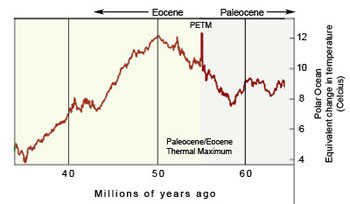Past climate change caused dramatic shift in humidity, precipitation levels, temperature, and ocean water salinity
Past climate change caused dramatic shift in humidity, precipitation levels, temperature, and ocean water salinity
mongabay.com
August 11, 2006
Scientists have uncovered new evidence of dramatic changes in humidity, precipitation levels, temperature, and ocean water salinity during a past episode of global warming.
Analyzing plant fossils collected in the Arctic, a team of researchers led by Mark Pagani, professor of geology and geophysics at Yale University, found that water and atmospheric water vapor are a major indicator of the “greenhouse” changes.
“Analysis of carbon and hydrogen isotopes in the recovered fossil plants told us a lot about the way water is transported in the atmosphere and its effect on the climate,” said Pagani. “The isotope traces we measured indicated that a large-scale alteration in the water cycle occurred and that future alterations may leave us poorly equipped to predict our water supply.”
|
“Without being hysteric, it is important to realize that the impact of global warming is not just about searing hot summers — it is about water as a resource. It is about when and where it rains and how much we have to drink. This is a red flag,” he added.
Pagani and his team measured carbon and hydrogen isotopes in the fossilized plant life and reconstructed the pattern of precipitation and characteristics of the ancient Arctic water.
“We are all familiar with what happens when atmospheric fronts from the tropics meet cool northern fronts — there is a “rainout” — water leaves the atmosphere,” explained Pagani. “When that happens, the water vapor isotope level becomes more negative. We were able to measure that as traces in the plant fossils.”
The results, published in the August 10 issue of Nature, confirm significant changes in precipitation and ocean salinity levels during the Palaeocene/Eocene thermal maximum (PETM) — a period of rapid, extreme global warming about 55 million years ago.
“In the PETM, because there were no sharp warm and cold fronts meeting to triggering rainfall, massive amounts of water got transferred from the tropics and sub-tropics to the arctic,” said Pagani. “That drastically increased humidity and precipitation in the arctic. In turn, it led to increased river runoff that lowered the ocean salinity, changing its oxygen capacity and the plant life in the region. It also probably left the middle latitudes a lot dryer.”
Matthew Huber, an assistant professor of earth and atmospheric sciences at Purdue University and co-author of the report, said the research confirms that the carbon dioxide level increase during the PETM was at least twice as large as those previously proposed.
“We now have a pretty good correlation between records of past warmth and higher carbon dioxide concentrations,” Huber said. “What it tells you is that it’s not too difficult to push the climate system to a warm state. If you work out the numbers, it’s almost identical to what we are expected to do over the next few hundred years.”
This article used quotes from a Yale Univesity news release.















